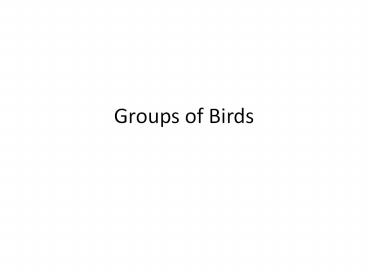Groups of Birds Bird Groups Bird species are ofte - PowerPoint PPT Presentation
1 / 16
Title:
Groups of Birds Bird Groups Bird species are ofte
Description:
Groups of Birds Bird Groups Bird species are often categorized into six groups based on the bird s lifestyle Perching birds Birds of prey Flightless birds Water ... – PowerPoint PPT presentation
Number of Views:151
Avg rating:3.0/5.0
Title: Groups of Birds Bird Groups Bird species are ofte
1
Groups of Birds
2
Bird Groups
- Bird species are often categorized into six
groups based on the birds lifestyle - Perching birds
- Birds of prey
- Flightless birds
- Water birds
- Wading birds
- Diving birds
3
Terrestrial (land) Birds
- Most perching birds, birds of prey, and
flightless birds are terrestrial birds - They live mainly on dry land
- Terrestrial birds have feet adapted to running,
perching, or hunting and beaks adapted to eating
fruits, seed, insects, or small animals
4
Perching Birds
- Are the most common group of birds
- In order to perch and grip onto branches
- One toe points backwards
- All other toes point forwards
- The beaks of perching birds are
- Strong for cracking open seeds and nuts
- Ex. Goldfinches
- Long thin beaks for catching insects in the air
or digging them out of the ground or tree trunks - Ex. Warbler
5
Birds of Prey
- Most Birds of prey are hunters with keen vision
- Eagles, hawks, and smaller birds of prey hunt
during the day - Owls have huge eyes and hunt for small prey
during the night - Some birds do not use vision to hunt
- Vultures rely on their incredible sense of smell
to find dead animals
6
Birds of Prey
- Most birds of prey have sharp talons and curved
beaks - Talons are used to grasp prey
- Curved beaks are used for tearing flesh
- Most birds of prey hunt alone
- However, some birds of prey hunt in groups and
flush prey towards their waiting partners
7
Flightless Birds
- Flightless birds are the largest birds
- The biggest flightless birds are ostriches, emus,
rheas, and cassowaries - There are some small flightless birds
- Example Flightless Kiwi is the size of a chicken
- They have small wings and are built to run on
land - Ostriches can run up to 55 km/h
8
Flightless Bird Legs
- Many flightless birds have long, strong legs
- Ostriches have two large, clawed toes on each
foot - Cassowary has powerful legs it uses to deliver
blows and uses its claws to tear at attackers
9
Aquatic Birds
- Diving birds, water birds, and wading birds are
aquatic birds - Live mainly in water
- Aquatic birds have feet adapted to paddling and
wading - Aquatic birds have beaks adapted to eating
aquatic organisms
10
Diving Birds
- Not all flightless birds live on land
- Penguins are flightless, and their wings and feet
have been adapted for swimming - All 17 species of penguins live in the Southern
Hemisphere - Some diving birds are found in the Northern
Hemisphere - Their wings can still be used for flight, so they
CANNOT dive as well as penguins can
11
Diving Birds Penguins
- Their wedge-shaped wings work as flippers
- Webbed feet can be used as paddles
- Have a thick coat of feathers and a layer of fat
beneath their skin that allows them to live in
freezing temperatures - A rich diet of krill and fish help penguins
maintain the fat layer
12
Water Birds
- Swan, Geese, and Ducks are water birds, or birds
found in or near the water - Water birds have webbed feet for paddling
- Have long, flattened beaks with rounded tips
- Beaks are ideal for a variety of food such as
small insects, fish, and grass
13
Seabirds
- Seabirds are an unrelated group of birds that
also live near open waters, but they are found
in oceans - They have webbed feet like water birds
- However, their beaks are longer
- Beaks are made for catching their typical meal of
fish or squid
14
Wading Birds
- Herons, storks, flamingos, and egrets are wading
birds - Wading birds feed in shallow waters that are rich
with fish and invertebrates - Wading birds have long, slender legs to feed in a
range of depths - Have long toes to keep them from sinking into the
mud
15
Wading Birds
- Many wading birds have spear-shaped beaks for
fishing - Fishing waders stand motionless as they wait for
fish - When they see a fish they quickly snatch it in
their beak or may even spear it - Waders that feed on invertebrates in the mud may
have beaks that are built for stabbing into the
mud to find prey
16
Review Questions
- 1. Relate the bald eagles methods of hunting and
feeding to its external body features - 2. Compare and Contrast the foot structure of
water birds and wading birds - 3. Classify a bird that has delicate, curved feet
with slender toes and a small, pointed beak (DO
NOT just write terrestrial/aquatic bird). Explain
how you know - 4. Like most birds penguins have large,
keel-shaped sternums, but ostriches do not.
Provide an explanation for this difference































